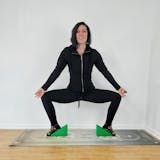In yoga, few postures embody serenity and renewal as profoundly as Child's Pose Yoga.
As a foundational pose, Child's Pose Yoga, also known as "Balasana," holds a special place in yoga practice, serving as a retreat into a posture that goes beyond physical alignment.
In this exploration, we unravel the significance of Child's Pose Yoga yoga, delving into its essence and highlighting the calming and renewing benefits that make it a cornerstone of mindful movement.
Child's Pose Yoga, also known as Balasana in yoga, is a fundamental and vital posture with numerous physical and mental benefits.
This pose is often practiced as a resting position during a yoga session, making it an integral part of many sequences.
Below are the basics of Child's Pose Yoga and its key benefits and variations.
Child's Pose Yoga (Balasana) Basics
 1. Starting Position
1. Starting Position
Begin in a tabletop position Position yourself on your hands and knees, Make sure your wrists are positioned beneath your shoulders, and your knees are aligned under your hips.
2. Kneeling
Gently lower your hips back Extend your arms in front of you as you move your chest towards your heels.
3. Forehead to the Mat
Place your forehead on the mat while allowing your chest to rest to sink towards the ground. Your arms should be stretched out in front of you or relaxed by your sides.
4. Knee Position
Adjust the positioning of your knees according to your comfort level, choosing to keep them together or spread them apart.
This choice can influence the intensity of the stretch in your hips and lower back.
5. Relaxation
Let your torso and shoulders release towards the mat, and focus on deepening your breath. Allow your body to relax and surrender to the pose.
6. Lengthen the Spine
While practicing Child's Pose in yoga, concentrate on elongating your spine by extending your tailbone away from your head.
This action contributes to a subtle stretch along the entirety of your back.
7. Duration
Hold the pose for as long as it feels comfortable, typically for a few breaths to a minute, depending on your practice and intention.
Child's Pose Yoga - Physical Alignment
Commence in a tabletop stance with hands and knees positioned on the mat ensuring wrists are under shoulders and knees under hips.
Gently move your hips backward toward your heels, initiating a mild stretch in the lower back and hips.
Reach your arms forward, lowering your chest towards the mat, and place your forehead on the ground.
Key Points of Child's Pose Yoga
Breathing Focus: Child's Pose Yoga encourages conscious, deep breathing.
Inhale and exhale slowly, allowing the breath to reach and expand the back of the body.
Spinal Stretch: The pose promotes a lengthening of the spine, releasing tension and promoting flexibility in the back.
Hips and Thighs: Child's Pose Yoga Offers a mild stretch to the hips, thighs, and ankles making it beneficial for individuals with tightness in these areas.
1. Mental and Emotional Aspects
Relaxation: Child's Pose Yoga is a resting position that invites a sense of calm and relaxation, This makes it a superb option for alleviating stress.
Mindfulness: This pose encourages introspection and mindfulness. As you bow your head to the mat, it creates a metaphorical and physical sense of turning inward.
2. Therapeutic Benefits
Back Pain Relief: Child's Pose Yoga can help Relieve tension and discomfort in the lower back making it therapeutic for individuals with back issues.
Stress Reduction: The forward-folding nature of the pose promotes a parasympathetic response, reducing stress and anxiety.
3. Variations and Modifications
- Extended Child's Pose Yoga: Stretch the arms forward to intensify the stretch along the spine.
- Wide-Knee Child's Pose Yoga: Open the knees wider for a different hip sensation.
- Puppy Pose: A variation where the hips remain elevated, deepening the stretch in the shoulders.
4. Integration into Yoga Sequences
- Child's Pose Yoga is often a transitional pose, providing a brief pause between more active asanas.
- It serves as a counterpose, balancing the effects of backbends and invigorating poses.
Ensuring Safety and Preventing Injuries in Yoga Practice.
- Start Slow
- Listen to Your Body
- Warm-Up
- Proper Alignment
- Use Props
- Modify Poses
- Balanced Practice
- Breath Awareness
- Stay Hydrated
- Child's Pose Yoga for Rest
- Professional Guidance
- Regular Check-ins
Conclusion
Mastering Child's Pose Yoga, or Balasana, unfolds as a journey of serenity and renewal within the vast landscape of yoga practice.
As a foundational and restorative posture, Child's Pose stands out as a refuge that transcends physical alignment, offering a retreat into tranquility and mindfulness.
Green Apple Active Wear specializes in designing activewear that goes beyond fashion, offering comfort, flexibility, and support tailored for enhancing your yoga practice.
If you're aiming to perfect your child's pose, their specially crafted apparel can be a game-changer.
Green Apple Active Wear's yoga flare leggings are crafted from fabrics chosen for their softness and breathability, ensuring maximum comfort during your child's pose.
The gentle touch against your skin allows you to fully relax into the stretch.
The apparel is designed to move with your body, providing the flexibility needed for the child's pose.
No restrictions or discomfort, just a seamless flow from one pose to another.
Visit greenappleactive.com to explore their range of activewear designed to elevate your yoga practice, and redefine your child's pose experience.


 1. Starting Position
1. Starting Position





